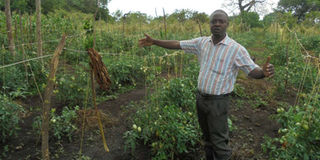Master tomato grower enjoys the big fruits of his labour

Jackson Ndurya in his tomato farm in Kwale. He mainly grows the Kilele F1 tomato variety, an open field hybrid that matures 75 days after transplanting. PHOTO | BOZO JENJE | NMG
What you need to know:
- Continuous cropping ensures the farmer has a stable supply of produce.
- The tomatoes grew well and matured after two-and-half months.
- Each day he harvests some seven crates, selling to hotels and schools at between Sh2,000 and Sh2,500 depending on market forces.
- Tomato production is capital intensive but the returns are good especially if you manage to keeps pests and diseases like root rot at bay.
Located 1km from Lunga Lunga Road at Kinondo in Kwale County, the four-acre farm hosts some coconut and cashew trees.
We meet Jackson Ndurya, the owner, at the gate of the farm on which he grows mainly tomatoes.
“I started farming in search of better returns since the job I had as a waiter was not paying well. My landlord challenged me to try horticulture farming in 2014 and I don’t regret it,” he offers.
Ndurya says before he took up the challenge, he sought advice from an agronomist, who took him through the steps of growing tomatoes, including the diseases he was to look out for and best husbandry practices.
A confident Ndurya soon ventured into the business, ploughing into it some Sh50,000. He used Sh24,000 to buy a generator, Sh15,000 went to a water pump and was offered 500 seedlings as a grant by a friend, growing the crop on a leased eighth-acre.
“The tomatoes grew well and matured after two-and-half months. I harvested 25 crates that I sold at Sh2,000 each earning Sh50,000. This was a motivation because buyers came to pick the produce from my farm,” he says.
Ndurya has now become a master tomato grower, a business he has perfected since then.
“I mainly grow the Kilele F1 crop, an open field hybrid that matures in 75 days after transplanting. At any time on the farm the crop is at five stages, that is, at the nursery, vegetative, fruiting, flowering and harvesting.”
At the nursery stage, Ndurya grows the crop on coco peat, a growing medium for hydroponics. He buys it at Sh1,000 for a dry 5kg block.
“Before I grow the seeds, I ensure that the peat is moist on the germination tray to enable the seeds to sprout. Then I water it for nine days, twice a day. I, thereafter, introduce fertiliser and the plants are ready for transplanting after 21 days,” he says.
He spaces the seedlings at 30cm between plants and 60cm between rows for easy weeding and harvesting.
During the flowering and fruiting stages, he prunes the plants and stalks them to keep the fruits off the ground.
“At this time, lots of manure is required. I apply CAN for top dressing or spray the crops with a calcium foliar feed to prevent the fruits from suffering blossom end rot,” says Ndurya, who grows the crop under irrigation.
He harvests the fruits daily just when they have started ripening to prevent the birds from feeding on them.
RULE OF SPECIALISATION
Each day he harvests some seven crates, selling to hotels and schools at between Sh2,000 and Sh2,500 depending on market forces.
Business is booming for Ndurya, with the farmer using the proceeds from his tomatoes to buy a car at Sh700,000, build a house for his three workers at Sh50,000 and dig a borehole.
The fulltime farmer is also using money from his agribusiness to educate his son at Kangaru High school.
“I have five workers, three who are always on the farm while the others come on need basis.”
However, as he savours success in the tomato business, Ndurya says he would never forget 2015, when a pest called tuta absoluta destroyed his 5,000 plants.
“I felt like giving up because this was a huge loss but this made me be keener on pests and diseases,” says Ndurya, noting cut worms and white flies are other pests that affect tomatoes, but there are readily available pesticides to eradicate them.
Dr Mwanarusi Saidi, a senior lecturer Department of Crops, Horticulture and Soils at Egerton University, says continuous cropping ensures that farmers have a continuous supply of produce to the market.
“Tomato production is capital intensive but the returns are good especially if you manage to keeps pests and diseases like root rot at bay,” she says, adding that farmers should also embrace drip irrigation for better returns.
The horticultural expert adds due to her experience in Kilele variety farming, she noted it grows well in Kinondo.
“It is not that Kilele is the best for Kinondo soil compared to Riograndie and Shanti but because of a longer experience in production of Kilele than the other varieties. I am capitalising on the rule of specialisation and taking comparative advantage of the experience,” she adds.”
She advices farmers to also choose the variety that grows well in their areas.
“For instance, Kilele grows well in Kinondo. It is is preferred because it is high-yielding compared to Riogrande and Shanti under the same conditions, besides having a longer harvesting period of about 8-10 weeks compared to 4-6 weeks for the others,” she says.
***
Consumption of tomatoes locally
In Kenya, a household consumes about 750g of tomatoes per day.
This is obtained from the estimated 24,074ha under tomato. According to the Horticultural Crops report in 2014, farmers produced 400,204 metric tonnes valued at approximately Sh11.8 billion.





